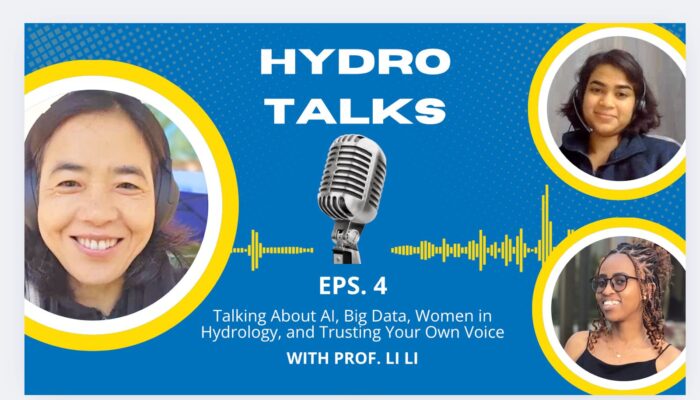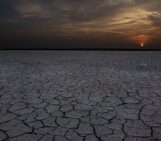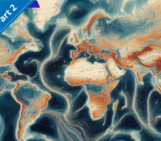
Welcome to HydroTalks, the EGU HS division’s podcast series. In this episode, we interviewed Prof. Li Li (Li Li – Penn State), leader of the Li Reactive Water group at Penn State University. We talked about her research on using data and models for hydro-biogeochemical processes, river water quality, climate change, and research communication. Her research sits at the intersection of hydrology, ecology, and biogeochemistry. We discussed her research and her efforts to promote women in hydrological sciences.
You can check out the podcast below, or read the interview summary in this blog!
EGU HydroTalks with Professor Li Li
Please give us a brief overview of your research.
Our group works at the intersection of hydrology, ecology and biogeochemistry. We aim to answer two broad questions. At large scales, we ask what and where and when patterns emerge. At the catchment scale, we ask why these patterns emerge. For example, why are there differences in river water chemistry response to changing discharge at different catchments.
How do you separate climate change signals from non-climate change-related background signals when we are in the middle of climate change?
We train deep learning models on decades of data from hundreds of sites. Comparing minimally and heavily human-impacted catchments across climates reveals systematic differences. We can observe how solute concentrations in minimally-impacted places differ in different climates. That gives you an idea of climate impacts without human impacts. For example, at minimally human-impacted sites, long-term salt concentrations are generally higher in arid regions.
How is the long-short term memory model used for water quality?
We can use LSTMs model to reproduce water-quality data (e.g., temperature, dissolved oxygen, nutrients) by learning their nonlinear relationship with rainfall, discharge, and climate. Training one single, large-scale model using data across many sites overcomes the limitation of sparse records, fills temporal and spatial gaps, and yields consistent data for cross-site comparisons and pattern detection.
How do you use a large continental-scale dataset such as CAMELS?
Datasets like CAMELS offers large datasets for data-hungry LSTMs. Data availability is often a challenge for training robust LSTM models. After robust training, we can use model output to ask questions about temporal trends and spatial distribution. For example, at the continental-scale, we found dissolved oxygen decreases faster at agricultural sites, despite slower water temperature increase. We hypothesised that this was due to higher nutrient and thus higher oxygen demands.
How does climate change modify the carbon cycle?
It’s impacted by both warming plus hydrological changes. For example, in mountains with lots of snow, as snowpacks get smaller, less snowmelt intensifies summer droughts, which can lead to more decomposition at higher temperature and possibly more CO₂ gas releases to the atmosphere. Storms can flush more dissolved carbon into streams and CO₂ gas into the atmosphere.
How do you think biogeochemical feedback loops will change carbon cycles?
Land and water are complex systems with multiple players. We know that wet, anoxic soils favour methane production and dry, oxic soils favour CO₂ production. Methane has much higher warming potential. With more extreme weather conditions, the balance of oxic and anoxic processes may be interrupted.
Why should this matter to people?
Often people think global scale problems are not individual responsibility. But individuals can take some steps, for example, changes in diet, or ways of transportation, to reduce our own carbon footprint. We as scientists should give people tangible actions.
What should be the next step to control water contamination?
Education and awareness first. If we change people’s perception, actions will follow. Scientists must communicate beyond journals. I’ve written (for example river heat waves and river deoxygenation) for an outlet called the Conversation, where researchers share accessible, public-friendly versions of their work.
Any tips for early-career science communication?
Making figures that carry the message on their own. Practice clarity and accessibility. Sharpen your story on “what’s new and why it matters”. I really think there should be more communication related training for PhD students.
What was your motivation to start the WARR seminar?
Ellen Wohl and I started this webinar in 2021, during COVID to promote women in river science. We wanted to build visibility and a community for women scientists. Each month, we host one early-career and one senior female scientist to share research. Videos are recorded and archived here in the WARR webpage.
What has been the biggest breakthrough in hydrological research in the last 10 years? And where do you see the trend going in the next 10 years?
I think one of the biggest breakthroughs was large-scale data synthesis powered by better sensors, large scale data compilation, and machine learning. Looking ahead, I believe measuring, modelling and understanding water chemistry on land and in rivers during climate extremes in places such as intermittent streams are crucial since these are some major future challenges.
What is the best and worst career advice you want to share with the ECS?
The best advice, especially for women scientists, is to listen to your own voice when making your decisions. You have to prioritise and focus on what really energize you and excites you.
Listen to the full conversation: EGU HydroTalks with Professor Li Li




